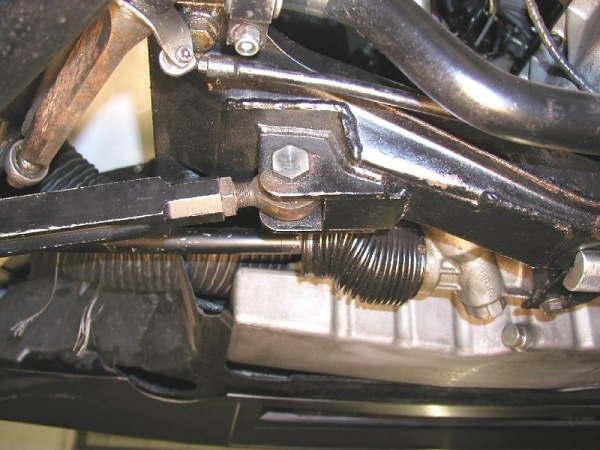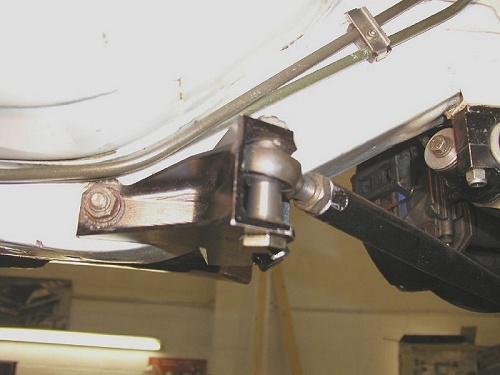
|
|
Some E30 M3 enthusiasts may have seen pictures like these of later model E30 M3 racecars (sporting BMW Motorsport parts), which have the inner ball joint area reworked. If one looks carefully it is apparent that the inner balljoint "node" is actually "pushed up" into the subframe, such that the center of rotation of the bearing is roughly 20-25mm higher in the vertical direction than it would be in the stock configuration. The most likely reason that this was done was to move the front roll center up, closer to the stock position. Since these cars were lowered extensively from the factory ride height, they suffered from a roll center which had moved downwards. The most significant effect of this is that it changes the camber curve for the front strut based suspension. This happens on any lowered E30 M3 chassis. As the car is lowered and the control arms attain a sloping upwards position, the gain in camber as the suspension compresses becomes less and less. To the point where there can be little to no negative camber gain whatsoever when the car leans in a corner. This means that every degree of chassis roll is directly translated to a degree loss in negative camber, and this occurs precisely when you need that negative camber on the outside front wheel the most - during cornering. Short of raising the car, one way to move the roll center height (and thereby improve the camber curve) is by changing the angle of the front control arms. And this can be done either by moving the outer ball joint down, or by moving the inner balljoint up (preferably both). That is what we see in these first two pictures. The inner control arm balljoint (pickup point) has been moved upwards, via a notch in the front subframe. Do not be misled by the fact that it is no longer a true balljoint, but rather a rod end turned on its side. The only thing that matters is the location of the node, i.e. the center of rotation of the balljoint or rod end. |

|
|
Note that if the inner front control arm pickup point is moved upwards, then the rear pickup on the control arm must be moved upwards by a similar amount. If this is not done, then it will change the amount of anti-dive built into the front suspension. In stock format the E30 M3 has no anti-dive, the front control arm is horizontal in the fore/aft direction. Its forward and rearward (lollipop) pickup points are at the same vertical height. To achieve anti-dive the rearward pickup must be raised above the forward pickup (a full discussion of anti-dive will be left for another article). If, as was done here, the front pickup point were raised, while leaving the rear pickup in the same place, then the car would actually incur negative anti-dive, which is of course pro-dive, and is not generally desirable. |

|
|
We can see in these two photos that this car uses a rear control arm pickup point which is adjustable for height via shims (spacers). And this has allowed the rear pickup to be moved upwards to match the forward pickup. I suspect that the pickup points were moved 20mm, since this was the common limit to relocation of pickup points in many Touring Car racing series throughout the 1990's. |

|
|
If you think about it, the best way to lower a car really, would be to simply lop off the spindles on all four corners, and weld them back on 2 or 3 inches farther up. That way the car would be lowered by that amount, with absolutely no change to any of the suspension geometry. This is an exaggerated example of course, but modification such as those shown here essentially accomplish the same effect. I don't mean to imply that the stock factory suspension geometry is necessarily ideal for a racecar, but most of the same principles apply. You want good camber gain, no bump steer, no lateral scrub, good self-centering etc... Racecars will usually dial in more caster, which stiffens the steering, but adds high speed stability and more importantly gives more dynamic negative camber on the outside front wheel when turning. Combine this with kingpin inclination and you also get an effect where the corner weights change as the front wheels are turned, in this case leading to decreased wedge (dynamic wedge) which adds more weight to the inside front wheel, not a bad thing. But most of this is best left for another article as well. |